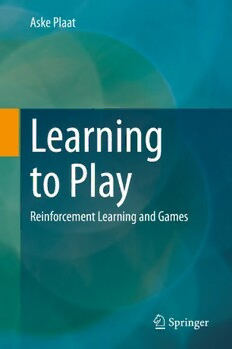Table Of ContentAske Plaat
Learning
to Play
Reinforcement Learning and Games
Learning to Play
Aske Plaat
Learning to Play
Reinforcement Learning and Games
Aske Plaat
Leiden Institute of Advanced Computer Science
Leiden University
Leiden, The Netherlands
ISBN 978-3-030-59237-0 ISBN 978-3-030-59238-7 (eBook)
https://doi.org/10.1007/978-3-030-59238-7
© Springer Nature Switzerland AG 2020
This work is subject to copyright. All rights are reserved by the Publisher, whether the whole or part of
the material is concerned, specifically the rights of translation, reprinting, reuse of illustrations, recitation,
broadcasting, reproduction on microfilms or in any other physical way, and transmission or information
storage and retrieval, electronic adaptation, computer software, or by similar or dissimilar methodology
now known or hereafter developed.
The use of general descriptive names, registered names, trademarks, service marks, etc. in this publication
does not imply, even in the absence of a specific statement, that such names are exempt from the relevant
protective laws and regulations and therefore free for general use.
The publisher, the authors, and the editors are safe to assume that the advice and information in this book
are believed to be true and accurate at the date of publication. Neither the publisher nor the authors or
the editors give a warranty, expressed or implied, with respect to the material contained herein or for any
errors or omissions that may have been made. The publisher remains neutral with regard to jurisdictional
claims in published maps and institutional affiliations.
This Springer imprint is published by the registered company Springer Nature Switzerland AG
The registered company address is: Gewerbestrasse 11, 6330 Cham, Switzerland
Tomystudents
Contents
1 Introduction................................................... 1
1.1 TuesdayMarch15,2016..................................... 1
1.2 IntendedAudience.......................................... 3
1.3 Outline ................................................... 5
2 IntelligenceandGames ......................................... 9
2.1 Intelligence................................................ 10
2.2 GamesofStrategy.......................................... 19
2.3 GamePlayingPrograms..................................... 32
3 ReinforcementLearning ........................................ 43
3.1 MarkovDecisionProcesses .................................. 44
3.2 PolicyFunction,State-ValueFunction,Action-ValueFunction ..... 47
3.3 SolutionMethods .......................................... 49
3.4 Conclusion................................................ 60
3.5 Practice................................................... 62
4 HeuristicPlanning ............................................. 71
4.1 TheSearch-EvalArchitecture ................................ 72
4.2 StateSpaceComplexity ..................................... 81
4.3 SearchEnhancements....................................... 85
4.4 EvaluationEnhancements ................................... 101
4.5 Conclusion................................................106
4.6 Practice...................................................108
5 AdaptiveSampling .............................................113
5.1 MonteCarloEvaluation .....................................114
5.2 MonteCarloTreeSearch ....................................116
5.3 *MCTSEnhancements......................................125
5.4 Practice...................................................130
vii
viii Contents
6 FunctionApproximation........................................135
6.1 DeepSupervisedLearning...................................136
6.2 *AdvancedNetworkArchitectures ............................156
6.3 DeepReinforcementLearning................................166
6.4 *DeepReinforcementLearningEnhancements.................. 177
6.5 Practice...................................................186
7 Self-Play ......................................................195
7.1 Self-PlayArchitecture.......................................196
7.2 AlphaGo.................................................. 207
7.3 *Self-PlayEnhancements....................................215
7.4 Practice...................................................228
8 Conclusion ....................................................233
8.1 ArtificialIntelligenceinGames...............................234
8.2 FutureDrosophilas .........................................239
8.3 AComputer’sLookatHumanIntelligence .....................244
8.4 Practice...................................................253
A DeepReinforcementLearningEnvironments......................255
B *AlphaGoTechnicalDetails .....................................259
B.1 AlphaGo..................................................259
B.2 AlphaGoZero .............................................262
B.3 AlphaZero ................................................265
C MatchesofFanHui,LeeSedol,andKeJie ........................ 267
D LearningtoPlayandProgramGoandChess...................... 277
D.1 LearningtoPlay ........................................... 277
D.2 LearningtoProgram........................................278
D.3 ScientificJournalsandConferences ...........................280
E RunningPython ............................................... 281
References.........................................................283
Figures............................................................ 319
Tables............................................................. 323
Algorithms ........................................................325
Index ............................................................. 327
Preface
Amazing breakthroughs in reinforcement learning have taken place. Computers
teach themselves to play Chess and Go and beat world champions. There is talk
aboutexpandingapplicationareastowardsgeneralartificialintelligence(AI).The
breakthroughsinBackgammon,Checkers,Chess,Atari,Go,Poker,andStarCraft
haveshownthatwecanbuildmachinesthatexhibitintelligentgameplayingofthe
highestlevel.Thesesuccesseshavebeenwidelypublicizedinthemedia,andinspire
AIentrepreneursandscientistsalike.Reinforcementlearningingameshasbecomea
mainstreamAIresearchtopic.Itisabroadtopic,andthesuccessesbuildonarange
ofdiversetechniques,fromexactplanningalgorithms,toadaptivesampling,deep
functionapproximation,andingeniousself-playmethods.
Perhapsbecauseofthebreadthofthesetechnologies,orbecauseoftherecency
ofthebreakthroughs,therearefewbooksthatexplainthesemethodsindepth.This
bookcoversallmethodsinonecomprehensivevolume,explainingthelatestresearch,
bringingyouascloseaspossibletoworkingimplementations,withmanyreferences
totheoriginalresearchpapers.
TheprogrammingexamplesinthisbookareinPython,thelanguageinwhich
mostcurrentreinforcementlearningresearchisconducted.Wehelpyoutogetstarted
withmachinelearningframeworkssuchasGym,TensorFlow,andKeras,andprovide
exercisestohelpunderstandhowAIislearningtoplay.
Thisisnotatypicalreinforcementlearningtextbook.Mostbooksonreinforcement
learningtakethesingle-agentperspective,ofpathfindingandrobotplanning.We
takeasinspirationthebreakthroughsingameplaying,andusetwo-agentgamesto
explainthefullpowerofdeepreinforcementlearning.
Boardgameshavealwaysbeenassociatedwithreasoningandintelligence.Our
games perspective allows us to make connections with artificial intelligence and
generalintelligence,givingaphilosophicalflavortoanotherwisetechnicalfield.
ix
x Preface
ArtificialIntelligence
EversincemyearlydaysasastudentIhavebeencaptivatedbyartificialintelligence,
bymachinesthatbehaveinseeminglyintelligentways.InitiallyIhadbeentaught
that,becausecomputersweredeterministicmachines,theycouldneverdosomething
new.YetinAIthesemachinesdocomplicatedthingssuchasrecognizepatterns,and
playChessgames.Actionsemergedfromthesemachines,behaviorthatappearednot
tohavebeenprogrammedintothem.Theactionsseemednew,andevencreative,at
times.
FormythesisIgottoworkongameplayingprogramsforcombinatorialgames
such as Chess, Checkers, and Othello. The paradox became even more apparent.
Thesegameplayingprogramsallfollowedanelegantarchitecture,consistingofa
searchfunctionandanevaluationfunction.1Thesetwofunctionstogethercouldfind
goodmovesallbythemselves.Couldintelligencebesosimple?
The search-evaluation architecture has been around since the earliest days of
computerChess.Togetherwithminimax,itwasproposedina1952paperbyAlan
Turing,mathematician,code-breakingwarhero,andoneofthefathersofcomputer
scienceandartificialintelligence.Thesearch-evaluationarchitectureisalsousedin
DeepBlue,theChessprogramthatbeatWorldChampionGarryKasparovin1997in
NewYork.
Afterthathistoricmoment,theattentionoftheAIcommunityshiftedtoanew
gamewithwhichtofurtherdevelopideasforintelligentgameplay.ItwastheEast
AsiangameofGothatemergedasthenewgrandtestofintelligence.Simple,elegant,
andmind-bogglinglycomplex.
Thisnewgamespawnedthecreationofimportantnewalgorithms,andnotone,but
two,paradigmshifts.Thefirstalgorithmtoupsettheworldviewofgamesresearchers
wasMonteCarloTreeSearch,in2006.Sincethe1950sgenerationsofgameplaying
researchers,myselfincluded,werebroughtupwithminimax.Theessenceofminimax
istolookaheadasfarasyoucan,tothenchoosethebestmove,andtomakesure
thatallmovesaretried(sincebehindseeminglyharmlessmovesdeepattacksmay
hidethatyoucanonlyuncoverifyousearchallmoves).AndnowMonteCarloTree
Searchintroducedrandomnessintothesearch,andsampling,deliberatelymissing
moves.YetitworkedinGo,andmuchbetterthanminimax.
MonteCarloTreeSearchcausedastrongincreaseinplayingstrength,although
notyetenoughtobeatworldchampions.Forthat,wehadtowaitanothertenyears.
In2013ourworldviewwasinforanewshock,becauseagainanewparadigm
shookuptheconventionalwisdom.Neuralnetworkswerewidelyviewedtobetoo
slowandtooinaccuratetobeusefulingames.ManyMaster’sthesesofstubborn
studentshadsadlyconfirmedthistobethecase.Yetin2013GPUpowerallowedthe
useofasimpleneuralnettolearntoplayAtarivideogamesjustfromlookingat
thevideopixels,usingamethodcalleddeepreinforcementlearning.Twoyearsand
muchhardworklater,deepreinforcementlearningwascombinedwithMonteCarlo
1Thesearchfunctionsimulatesthekindoflook-aheadthatmanyhumangameplayersdointheir
head,andtheevaluationfunctionassignsanumericscoretoaboardpositionindicatinghowgood
thepositionis.
Preface xi
TreeSearchintheprogramAlphaGo.Thelevelofplaywasimprovedsomuchthata
yearlaterfinallyworldchampionsinGowerebeaten,manyyearsbeforeexpertshad
expectedthatthiswouldhappen.Andinothergames,suchasStarCraftandPoker,
self-playreinforcementlearningalsocausedbreakthroughs.
The AlphaGo wins were widely publicized. They have had a large impact, on
science,onthepublicperceptionofAI,andonsociety.AIresearcherseverywhere
wereinvitedtogivelectures.Audienceswantedtoknowwhathadhappened,whether
computers finally had become intelligent, what more could be expected from AI,
andwhatallthiswouldmeanforthefutureofthehumanrace.Manystart-upswere
created,andexistingtechnologycompaniesstartedresearchingwhatAIcoulddofor
them.
The modern history of computer games spans some 70 years. There has been
much excitement. Many ideas were tried, some with success. Games research in
reinforcementlearninghaswitnessedmultipleparadigmshifts,goingfromheuristic
planning,toadaptivesampling,todeeplearning,toself-play.Theachievementsare
large,andsoistherangeoftechniquesthatareused.Wearenowatapointwherethe
techniqueshavematuredsomewhat,andachievementscanbedocumentedandput
intoperspective.
Inexplainingthetechnologies,Iwilltellthestoryofhowonekindofintelligence
works,theintelligenceneededtoplaytwo-persongamesoftacticsandstrategy.(As
toknowingthefutureofthehumanrace,surelymoreisneededthananunderstanding
ofheuristics,deepreinforcementlearning,andgameplayingprograms.)Itwillbea
storyinvolvingmanyscientists,programmers,andgameenthusiasts,allfascinated
bythesamegoal:creatingartificialintelligence.Comeandjointhisfascinatingride.

